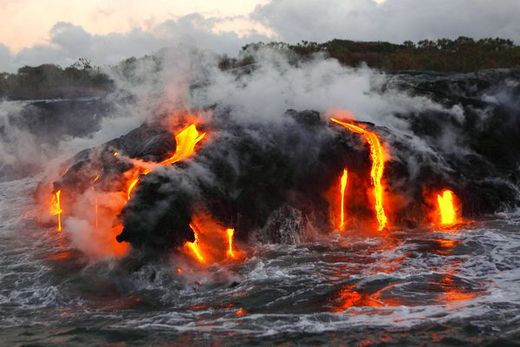
(See pictures of a recent eruption Hawaii's Kilauea volcano.)
Scientists say they've found solid evidence of a giant mass of hot rock under the seafloor in the region. But it's not a plume running straight from the core to the surface - and it's hundreds of miles west of the nearest Hawaiian island.
Until now, the researchers say, good seismic data on the region has been scarce, so it was tough to question the traditional explanation: that a stream of hot rock directly from around Earth's core formed the 3,100-mile-long (5,000-kilometer-long) chain of islands and undersea mountains in the Pacific Ocean.
As Earth's crust slid over the plume, as if on a conveyor belt, the erupting seafloor built mounts, mountains, and islands out of layers of cooled lava over tens of millions of years - or so the conventional wisdom goes.
But after analyzing 20 years' worth of earthquake data, geophysicists say they've found an 800-mile-wide (1,300-kilometer-wide) region of hot rock in the Hawaiian region - but nothing beneath the Big Island of Hawaii. The island, the youngest in the chain, is traditionally thought to be above the purported plume.
Although the new evidence flies in the face of the giant-plume theory, "we can't rule out a narrow plume below the island, but the main source comes from a different place. It can't be linked directly below," said geophysicist Robert van der Hilst of MIT, co-author of the new study, led by his colleague Qin Cao and appearing online today in the journal Science.
Hawaii Plume Takes Deep Detour?
Volcano formation starts where Earth's mantle - the planet's thickest rock layer - meets the molten outer core, some 1,800 miles (2,900 kilometers) below the surface.
The outer core heats the mantle's bottom rocks into buoyant putty, which rises toward the crust, as if in a lava lamp. Within a few miles of the crust, the rock decompresses, melts, and often oozes - or erupts - out of the Earth's surface.
A technique called seismic tomography uses the sounds of earthquakes rippling through the planet and bouncing around to detect such plumes, or hot spots. But this kind of data has been limited for Hawaii.
"It's been very difficult to image the mantle below Hawaii, simply because it's so far away from [large] seismic-sensor networks," van der Hilst said. Data suggesting a plume directly below the island is very limited and based on relatively narrow sampling by seismic waves, he said.
By contrast, Van der Hilst said, the new study analyzed two decades' worth of seismic data and extracted subtle but clear signals.
Those signals point to the giant anomaly, about 410 miles (660 kilometers) down: a relatively disklike segment of rock between 540 and 720 degrees Fahrenheit (300 and 400 degrees Celsius) hotter than its surroundings and between 370 miles (600 kilometers) and 1,000 miles (1,600 kilometers) west of the Big Island.
The team suspects the plume is pooling at the boundary between the upper and lower mantle, then snaking its way to the crust below the archipelago before rising to feed Hawaii's volcanic islands.
More evidence is needed before it's known for sure what's stoking the volatile island chain, but at the least, the new study "shows the process of how our planet loses heat is more complicated than we thought," van der Hilst said. It may also help explain how other Pacific seamounts came to be, he added.



Reader Comments
to our Newsletter